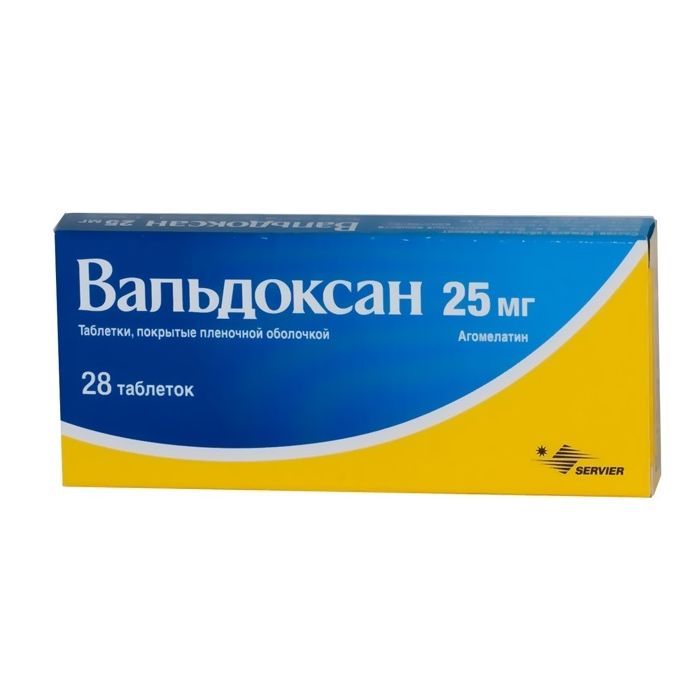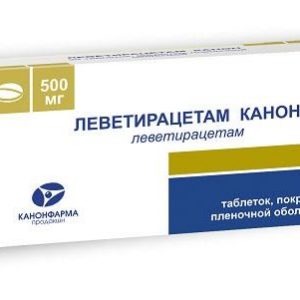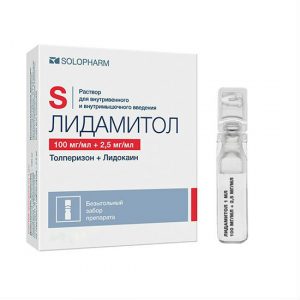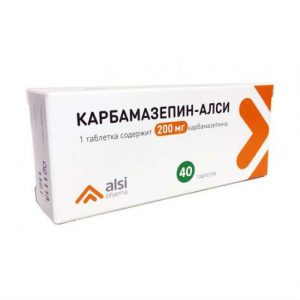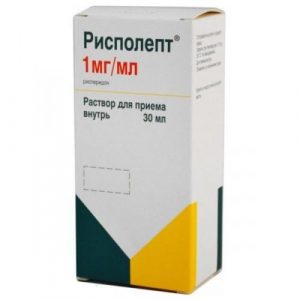Description
Release form
Film-coated tablets
Packing
28 pcs.
Indications
Treatment for major depressive disorder.
Contraindications
Hypersensitivity to agomelatine and / or any of the excipients of the drug.
Hepatic insufficiency (for example, cirrhosis or liver disease in the active phase) or an increase in transaminases more than 3 times relative to the upper limit of normal.
Concomitant use of potent inhibitors of the CYP1A2 isoenzyme (such as fluvokeamine, ciprofloceacin).
Children under 18 years of age (due to lack of sufficient clinical experience). In children and adolescents, while taking other antidepressants, suicidal behavior (suicide attempts and suicidal thoughts) and hostility (mainly aggressiveness, conflict behavior, irritation) were noted more often compared with the placebo group.
The drug should not be used in patients with lactose intolerance: lactase deficiency, galactosemia and glucose-galactose malabsorption.
Precautions for using
Patients with moderate to severe renal failure in the treatment of major depressive episodes, while the appointment of agomelatine with moderate inhibitors of the isoenzyme CYP1A2 (such as propranolol, enoxacin), patients with manic or hypomanic episodes in anamnesis patients with a history of suicide-related events, as well as patients who had suicidal intent before starting therapy.
Caution should be exercised when prescribing the drug to patients who abuse alcohol or are taking drugs that can cause liver dysfunction.
Use during pregnancy and lactation
Insignificant experience with the use of agomelatine in pregnant women did not show any side effects on pregnancy, fetal or newborn health. There is currently no other epidemiological information available on this subject. During pregnancy, the drug should be used with caution and in cases where the expected benefit of therapy for the mother outweighs the potential risk to the fetus.
It is not known whether agomelatine is excreted in human milk with breast milk. If it is necessary to use Valdoxan during lactation, breastfeeding should be discontinued.
In experimental animal studies, no direct or indirect harmful effects of the drug on pregnancy, the development of an embryo or fetus were found, labor or postnatal development. It was shown that agomelatine and its metabolites are excreted in breast milk in rats. Insignificant experience with the use of agomelatine in pregnant women did not show any side effects on pregnancy, fetal or newborn health. There is currently no other epidemiological information available on this subject. During pregnancy, the drug should be used with caution and in cases where the expected benefit of therapy for the mother outweighs the potential risk to the fetus.
It is not known whether agomelatine is excreted in human milk with breast milk. If it is necessary to use Valdoxan during lactation, breastfeeding should be discontinued.
In experimental animal studies, no direct or indirect harmful effects of the drug on pregnancy were found, embryo or fetal development, labor or postnatal development. Agomelatine and its metabolites have been shown to be excreted in breast milk in rats.
Specific guidelines
Monitoring liver function indices:
Reported cases of liver damage, including liver failure (resulting in exceptional cases fatal or requiring liver transplantation in patients with previously existing risk factors for liver damage), an increase in the level of liver enzymes by more than 10 times relative to the upper limit of normal, hepatitis and jaundice in patients taking Valdoxan ® in the post-registration period. Most of these disorders occurred in the first months of treatment. The nature of the liver lesion appears to be mainly hepatocellular. As a rule, after discontinuation of therapy, transaminase levels returned to normal values.
Caution should be exercised before starting treatment and careful monitoring during treatment for all patients, especially those with risk factors for developing liver disease or receiving concomitant therapy with drugs that can cause liver damage.
Prior to
therapy, treatment with Valdoxan ® should only be prescribed after a careful assessment of the expected benefit versus potential risk in patients with risk factors for liver dysfunction, such as: obesity / overweight / non-alcoholic fatty hepatosis, diabetes,
alcoholism and / or
alcohol abuse and taking drugs that can cause liver dysfunction.
Before starting therapy, functional liver tests should be performed in all patients, and therapy cannot be started if the level of liver enzymes AJIT and / or ACT is more than 3 times the upper limit of normal. Caution should be exercised when prescribing Valdoxan ® to patients with initially increased transaminase activity (above the upper limit of normal, but no more than 3 times relative to the upper limit of the norm). The frequency of liver function tests Before starting
therapy And then: after about 3 weeks,
after about 6 weeks (end of the stopping period of therapy),
after about 12 and 24 weeks (end of the maintenance period of therapy)
in the future – in accordance with the clinical situation.
With an increase in dose, liver function should be monitored with the same frequency as at the beginning of therapy.
With an increase in the activity of transaminases in the blood serum, a repeat study should be carried out within 48 hours. During
treatment, treatment with Valdoxan ® should be discontinued immediately if: the onset of symptoms and signs of possible impaired liver function (such as dark urine, discolored stool, yellowness of the skin / eyes, pain in the upper right abdomen, recent persistent and unexplained fatigue).
increased levels of transaminases more than 3 times, compared with the upper limit of the norm.
After discontinuing therapy with Valdoxan ®, regular liver function tests should be performed regularly to normalize transaminase levels.
Elderly patients
The efficacy of the drug in elderly patients (75 years of age and older) has not been established. In this regard, Valdoxan ® should not be prescribed to patients of this age group.
Elderly patients with dementia
Valdoxan ® should not be prescribed for the treatment of major depressive episodes in elderly patients with dementia (due to the lack of data on the efficacy and safety of the drug in this group of patients).
Patients with renal failure
In patients with severe renal failure, there was no significant change in pharmacokinetic parameters. However, experience with the use of the drug Valdoxan ® in large depressive episodes in patients with moderate to severe renal failure is limited. When prescribing Valdoxan ® to such patients, caution should be exercised.
Bipolar Disorders / Mania / Hypomania
Caution should be exercised when using Valdoxan ® in patients with a history of bipolar disorders, manic or hypomanic episodes. If symptoms of mania appear, stop taking the drug.
Suicide / suicidal behavior
When depressed, there is an increased risk of suicidal thoughts, self-harm, and suicide (suicide-related events). The risk persists until a clear remission occurs. Patients should be under medical supervision until the condition improves (after the start of therapy, it may take several weeks before the condition improves). Clinical experience suggests that the risk of suicide may increase in the early stages of remission.
Patients with a history of suicide related events, as well as patients who had suicidal intent before starting treatment, are at risk and should be closely monitored during treatment.
The results of a meta-analysis of clinical trials of antidepressants in patients with mental disorders indicate an increased risk of suicidal behavior in patients under 25 years of age with antidepressants compared with placebo.
During treatment, patients, especially those at risk, should be under close medical supervision, especially at the beginning of therapy and when changing the dose of the drug. Patients (and their carers) should be informed about the need to immediately consult a doctor if the condition worsens, suicidal and unusual behavior, as well as when suicidal thoughts appear.
Co-administration with CYP1A2 isoenzyme inhibitors
Caution should be exercised while using agomelatine with moderate inhibitors of CYP1A2 isoenzyme (such as propranolol, enoxacin) because of the possibility of increasing agomelatine concentration.
Patients with lactose intolerance
The drug should not be used in patients with lactose intolerance: lactase deficiency, galactosemia and glucose-galactose malabsorption.
Influence on the ability to drive vehicles and mechanisms
No studies have been conducted on the effects of Valdoxan ® on the ability to drive a car and other mechanisms. It should be remembered that dizziness and drowsiness are frequent side effects of agomelatine.
Composition
1 tablet contains:
Active ingredient: active substance agomelatine 25 mg.
Excipients: lactose monohydrate, magnesium stearate, corn starch, povidone, colloidal silicon dioxide, sodium carboxymethyl starch, stearic acid.
Film coat: glycerol, hypromellose, yellow iron oxide, macrogol 6000, magnesium stearate, titanium dioxide.
Dosage and Administration
Inside. Valdoxan ® tablets can be taken without regard to meals. The tablet should be swallowed whole without chewing.
If you skip taking the next dose of the drug, during the next dose, Valdoxan ® is taken in the usual dose (do not take the missed dose). To improve patient monitoring of drug administration, a calendar is printed on a blister containing tablets.
Recommended daily dose is 25 mg (1 tablet) once before bedtime. In the absence of clinical dynamics after a two-week treatment, the dose can be increased to 50 mg (2 tablets of 25 mg) once before bedtime.
A decision to increase the dose should be made considering the increasing risk of increased transaminases. Any increase in dose to 50 mg should be done based on an assessment of the benefits and risks for a particular patient and with strict monitoring of liver samples.
Before starting therapy, functional liver tests should be performed in all patients. Therapy cannot be started in patients with transaminases more than 3 times the upper limit of normal. During treatment, liver function should be monitored periodically, after approximately 3 weeks, approximately 6 weeks (end of the stopping period of therapy), approximately 12 weeks and 24 weeks (end of the maintenance period of therapy) after the start of therapy, and subsequently in accordance with the clinical situation . If the activity of transaminases is more than 3 times higher than the upper limit of normal, the drug should be discontinued. With an increase in dose, liver function should be monitored with the same frequency as at the beginning of the use of the drug.
Duration of treatment
Drug therapy for depression should be given at least within 6 months until the symptoms of depression disappear completely.
Transition from SSRI / SSRI therapy to agomelatine therapy
Syndrome may occur after discontinuation of SSRI / SSRI.
To reduce the risk of withdrawal after discontinuing treatment with previously prescribed SSRIs / SSRIs, you must follow the instructions for medical use of these drugs.
Reception of agomelatine can be started from the 1st day of a gradual reduction in the dose of SSRI / SSRI antidepressants.
Discontinuation of treatment
If treatment is discontinued, there is no need for a gradual dose reduction.
Elderly patients
The efficacy and safety of agomelatine (at a dose of 25-50 mg per day) has been confirmed in patients with older depression under the age of 75 years. Patients 75 years of age and older do not have evidence of a significant effect. In this regard, Valdoxan ® should not be prescribed to patients of this age group. Dose adjustment based on age is not required.
Patients with renal failure
In patients with severe renal failure, there was no significant change in pharmacokinetic parameters. The experience of using Valdoxan ® in large depressive episodes in patients with moderate and severe renal failure is limited. When prescribing Valdoxan ® to such patients, caution should be exercised.
Patients with liver failure
Valdoxan ® is contraindicated in patients with liver failure.
Side effects of
In clinical trials, Valdoxan ® received more than 8000 patients with depression.
Side effects were most often mild or moderate and were observed in the first two weeks of treatment. The most commonly reported headaches, nausea and dizziness. Reported side effects, as a rule, were transient and, basically, did not require discontinuation of treatment. The following are data on side effects observed during placebo-controlled and comparative clinical trials.
The frequency of side effects of agomelatine is given in the form of the following gradation: very often (> 1/10), often (> 1/100, <1/10), infrequently (> 1/1000, <1/100), rarely (> 1/10000, <1/1000) very rarely (<1/10000), unspecified frequency. From the central nervous system Very often: headache Often: dizziness, drowsiness, insomnia. Infrequently: migraine, paresthesia, restless legs syndrome *. Rarely: akathisia *. From the gastrointestinal tract Often: nausea, diarrhea, constipation, abdominal pain, vomiting *. Disorders of the liver and biliary tract: Often: increased AJIT and / or ACT activity (more than 3 times compared with the upper limit of normal in 1.2% of patients with agomelatine at a dose of 25 mg per day and 2 , 6% of patients taking agomelatine at a dose of 50 mg per day, compared with 0.5% with placebo in clinical trials). Infrequently: increased activity of? -glutamyltransferase * (GGT) (more than 3 times compared with the upper limit of normal) Rarely: hepatitis, increased activity of alkaline phosphatase * (more than 3 times compared with the upper limit of normal), liver failure * ( 1), jaundice *. From the skin and subcutaneous tissue Infrequently: sweating, eczema, skin itching *, urticaria *. Rarely: erythematous rash, facial edema, and Quincke edema *. On the part of the hearing organ Infrequently: tinnitus *. From the organ of vision Infrequently: blurry vision. From the musculoskeletal system Often: back pain. Disorders of the kidneys and urinary tract Rarely: urinary retention *. Common disorders Often: fatigue. Mental disorders Often: anxiety, unusual dreams *. Infrequently: suicidal thoughts or suicidal behavior, agitation and related symptoms * (such as irritability and anxiety), aggressiveness *, nightmares *, mania / hypomania * (these symptoms may also be a manifestation of the underlying disease), confusion *. Rarely: Hallucinations *. Data from (additional) surveys Often: weight gain *. Infrequently: weight loss *. * Estimates of the frequency of adverse reactions identified by spontaneous reports have been based on clinical studies. (1) Only a few deaths or liver transplants have been reported in patients with previously existing risk factors for liver damage. Drug Interactions Potentially possible effects of other drugs Agomelatine is 90% metabolized in the liver by cytochrome P450 1A2 (CYP1A2) and 10% by CYP2C9 / 19. Therefore, any drugs whose metabolism depends on these isoenzymes can increase or decrease the bioavailability of agomelatine. Fluvoxamine is a strong inhibitor of the CYP1A2 isoenzyme and a moderate inhibitor of the CYP2C9 isoenzyme and significantly slows down the metabolism of agomelatine, while the concentration of agomelatine increases on average 60 (12 – 412) times. Therefore, the simultaneous use of agomelatine and strong inhibitors of the CYP1A2 isoenzyme (such as fluvoxamine, ciprofloxacin) is contraindicated. Concomitant administration of agomelatine and estrogen, which are moderate inhibitors of the CYP1A2 isoenzyme, leads to an increase in the concentration of agomelatine several times. Although the combined use of agomelatine and estrogen was not accompanied by a deterioration in the safety profile of the therapy, caution should be exercised while prescribing agomelatine with other moderate inhibitors of the CYP1A2 isoenzyme (such as propranolol, enoxacin) until sufficient clinical experience has been gained (see the section Special Instructions ). Rifampicin, as an inducer of all three isoenzymes involved in agomelatine metabolism, may decrease the bioavailability of agomelatine. Smoking has been shown to induce the isoenzyme of CYP1A2 to reduce the bioavailability of agomelatine, especially in patients who abuse smoking (> 15 cigarettes / day).
Potentially possible effects of agomelatine on other drugs
In vivo agomelatine does not induce cytochrome P450 isoenzymes. Agomelatine does not inhibit the CYP1A2 isoenzyme in vivo and other in vitro cytochrome P450 isoenzymes.
Therefore, agomelatine does not affect the concentration of drugs whose metabolism is associated with these isoenzymes.
Drugs that bind to plasma proteins to a large extent Agomelatine did not change the free concentration of drugs that bind to plasma proteins to a large extent and, in turn, did not affect the concentration of agomelatine.
Other medicines
No pharmacokinetic and pharmacodynamic interactions of agomelatine and drugs often used in the target patient population: benzodiazepines, lithium preparations, paroxetine, fluconazole and theophylline.
Alcohol
The use of agomelatine in conjunction with alcohol is not recommended.
Electroconvulsive therapy (ECT)
There are no data on the use of agomelatine simultaneously with ECT. Since agomelatine did not contribute to seizures in animal experiments, the undesirable consequences of the combined use of agomelatine and ECT are unlikely.
Overdose
Agomelatine overdose is limited.
Symptoms: drowsiness, epigastric pain, anxiety, weakness, anxiety, agitation, tension, dizziness, cyanosis, malaise.
When receiving patient agomelatine at a dose of 2450 mg, the condition normalized on its own, without disturbances from the cardiovascular system or changes in laboratory parameters.
Treatment for
No specific antidotes for agomelatine are known. Symptomatic treatment and monitoring in specialized units followed by observation.
Storage conditions
In a protected place from light, at a temperature not exceeding 25 ° C.
Shelf life
3 years
Deystvuyushtee substance
Aglomelantin
Terms and conditions
prescription
dosage form
tablets
Possible product names
VALDOXAN 0.025 N28 TABLE P / O
VALDOXAN 0.025 N28 TABLE P / FILM / SHELL
Valdoxan 25mg Tab. p / pl / rev X28
Valdoxan 25mg No. 28 Tab 2015
Valdoxan 25MG. No. 28 TAB. P / O
Servier, France
